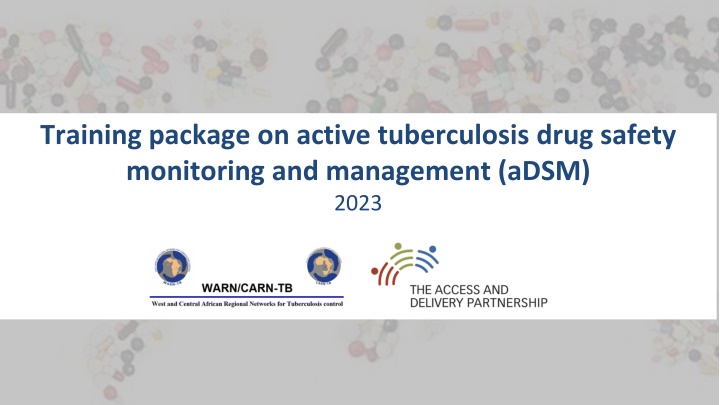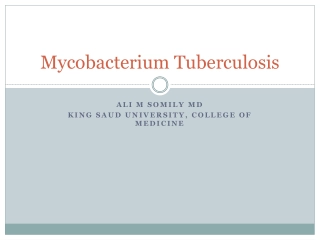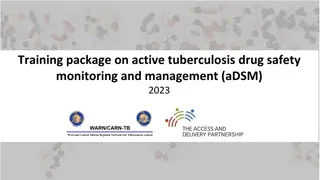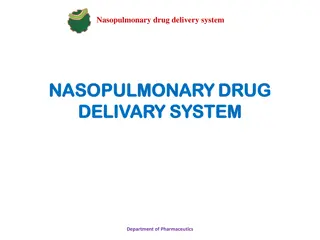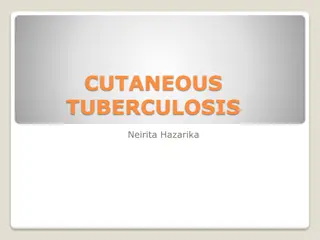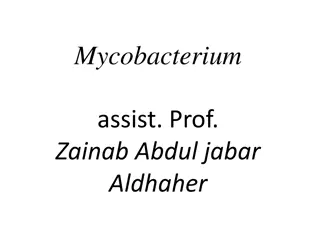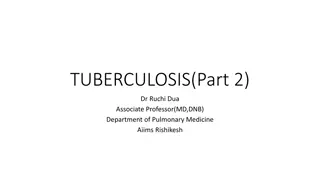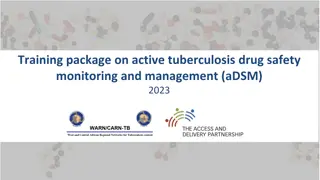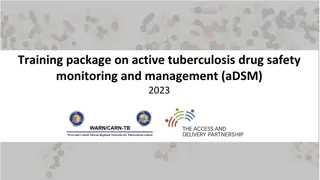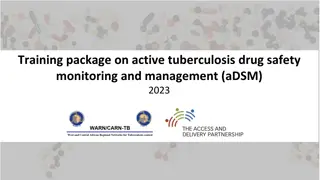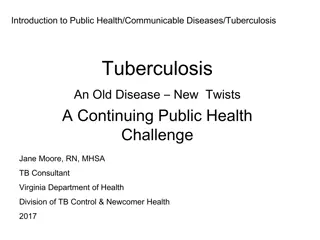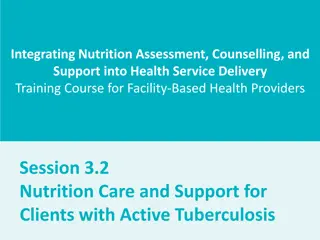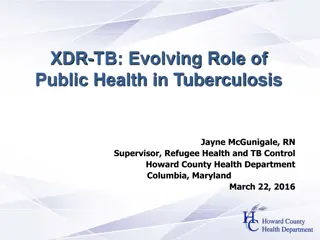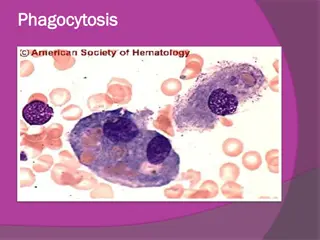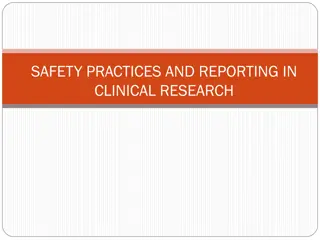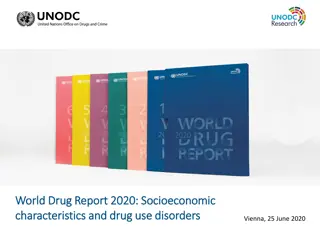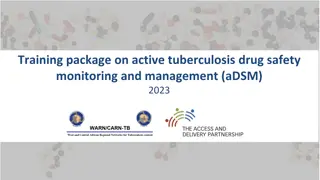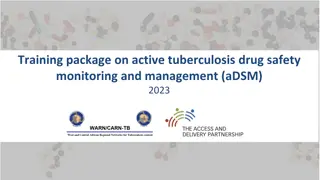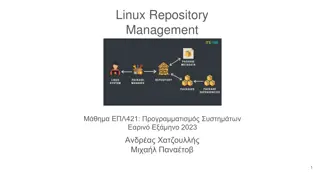Training Package on Active Tuberculosis Drug Safety Monitoring
This training package provides insights on active tuberculosis drug safety monitoring and management (aDSM). It covers risk communication, new knowledge integration, TB medicine risks, aDSM's role in risk reduction, and communication methods for new risk knowledge. The content emphasizes the importance of reducing drug-related harms in TB patients undergoing second-line treatment, generating standardized TB drug safety data, and making informed decisions based on new knowledge gained.
Download Presentation

Please find below an Image/Link to download the presentation.
The content on the website is provided AS IS for your information and personal use only. It may not be sold, licensed, or shared on other websites without obtaining consent from the author.If you encounter any issues during the download, it is possible that the publisher has removed the file from their server.
You are allowed to download the files provided on this website for personal or commercial use, subject to the condition that they are used lawfully. All files are the property of their respective owners.
The content on the website is provided AS IS for your information and personal use only. It may not be sold, licensed, or shared on other websites without obtaining consent from the author.
E N D
Presentation Transcript
Training package on active tuberculosis drug safety monitoring and management (aDSM) 2023
3.4. Overview on risk communication and new knowledge integration
Learning objectives By the end of this presentation, the participant is expected to be able to: 1. Define TB medicine risk 2. Understand the aDSM role in risk reduction 3. Describe risk communication methods 4. Describe new risk knowledge communication and integration for TB drugs
TB medicine risk (1) Basics A risk is the probability that an unwanted or unexpected medical event could result from a medical procedure or the use of a medical product The risk could be known or unknown o some may have already been identified from clinical studies and some may not have been identified before approval for public use
TB medicine risk (2) All anti-TB medicines have inherent risk to the patients o some are avoidable whereas others are not Most clinical trials for medicines are tested only in limited populations o there are many unknowns regarding how a wider population (elderly, children, pregnant females, patients with comorbidities, ethnic variations, etc.) will react to the same medicine
aDSM and medicine risk (1) WHO Global TB Programme The overall objectives of aDSM are to o Reduce risks from drug-related harms in patients on second-line treatment for drug-resistant TB o Generate standardized TB drug safety data to inform future policy updates on the use of such medicines
aDSM and medicine risk (2) National Tuberculosis Programmes The objectives of aDSM are to o Data are collected, reported and analyzed; and decisions are made on the basis of new knowledge gained
Communicating new knowledge on risk Before communicating a signal (e.g. newly suspected drug- related harm), a thorough ascertainment is needed to avoid the needless blaming of a drug The reputation of a drug or a regimen could be easily damaged if attribution of risk is not carefully conducted and communicated This could also have repercussions on the whole treatment programme
Communicating techniques & media (1) Visual aids such as tables, charts, graphs, and photographs can be used effectively to summarize information and add a visual aspect to a written report or oral presentation o Update policies and procedures o Provide education and training on updated policies and procedures
Communicating techniques & media (2) The most common means of dissemination of new information include: Health care provider letters or e-mails Safety alerts Press releases (e.g. via Internet, TV, ) Oral presentations at technical meetings Fact sheets, posters, flyers Peer-reviewed publications Revised product inserts
Integrating new knowledge (1) One important result of the communication of risk is to incorporate the new knowledge into different material used to guide practice. These include National TB guidelines Essential medicines lists, national formularies Product inserts Textbooks Training materials
Integrating new knowledge (2) Updated training materials would be oriented to different audiences, including formal health care providers community health workers informal carers peer support groups expert patients community champions They can be supplemented by information-sharing sessions to educate patients, their families and communities
Communicating approaches (1) 1. Accept and involve the public as a legitimate partner o Involve the community early, before important decisions are made 2. Plan carefully and evaluate performance o Different goals, audiences and media require different risk communication strategies o Risk communication will be successful only if carefully planned o Carefully evaluate your efforts and learn from your mistakes
Communicating approaches (2) 3. Listen to your audience If you do not listen to people, you cannot expect them to listen to you Communication is a two-way activity Do not make assumptions about what people know, think, or want, done about risks 4. Be honest, frank and open State your credentials; but do not ask or expect to be trusted by the public If you do not know an answer or are uncertain, say so Get back to people with answers. Admit mistakes Disclose risk information as soon as possible
Communicating approaches (3) 5. Coordinate and collaborate with other credible sources and try to issue communications jointly with other trustworthy sources such as regulatory bodies authoritative university scientists physicians trusted local officials opinion leaders
Communicating approaches (4) 6. Meet the needs of the media Be open with and accessible to reporters Respect their deadlines Provide information tailored to the needs of each type of media, such as graphics and other visual aids for TV Provide background material for the media on complex risk issues Follow up on stories with praise or criticism Try to establish long-term relationships of trust with editors and reporters
Communicating approaches (5) 7. Speak clearly and with compassion Use simple, non-technical language Always try to include a discussion of actions that are under way or can be taken Promise only what you can do, and be sure to do what you promise
Conclusions Risk communication and integration of new knowledge justify much of the efforts and resources devoted to aDSM Before communicating a drug-related risk, a thorough ascertainment is needed to avoid the needless blaming of a drug Different methods and approaches can be used to communicate a message clearly, taking advantage of the diversity of means available today
Acknowledgements The development of the aDSM training material was funded by TDR as part of the Access and Delivery Partnership (ADP) with funding from the Government of Japan. These training materials were put together in 2016 the WHO Task Force on aDSM with technical partners KNCV Tuberculosis Foundation, Management Sciences for Health (SIAPS), MSF, WHO GTB, and TDR. The materials were updated in 2022-23 by Mahamadou Bassirou Souleymane (TDR consultant) with Marie-Eve Raguenaud (TDR), Branwen J Hennig (TDR), and Corinne Merle (TDR), and reviewed by Linh Nhat Nguyen (WHO/GTB), Medea Gegia (WHO/GTB), and Fuad Mirzayev (WHO/GTB). We thank all members of the WARN/CARN-TB working group on aDSM who contributed to the development of the aDSM generic guidelines as well as the secretariat, particularly Dr Christ Houessinon: Disadidi Ambrioso, Esse Marius, Adomou Jamal Rouamba Ruffine, Haro Sougrimani, Koumbem Boureima, Nsanzerugeze Jos lyne, Tollo Tollo Daniel Alphonse D sir , Mpaba Minkat Th ophile Mistral, Julie Abessolo, Ursule IDOKO, Tijan Baldeh , Wandifa Samateh, Tida S Kinteh, Alieu Wurie, Mardemn Yeasuen, Benjamin K. Quenneh, Cheick Oumar Bah, Kane El Hadj Malick, Aw Idriss, Mamoudou Hama Rachida, Gagara I. M. Assiatou, Katamb Balkissa, Seiyabatou ElhSaidou, Liombo Anastasie, Lunganyu Junior, Kitambala Sentime, Lula Yves , Habimana-Mucyo Yves, Migambi Patrick, dos Santos Brigite, Castro V nia, Wadson Cruz, Gueye Aminata, Mukeh Fahnbulleh, Bailor Samuel, Manjo Lamin, Saleh Mahareb Abdoulaye, Haroun Saleh Naima, Mouhoudine Yerima, Kpelafia Silifa
